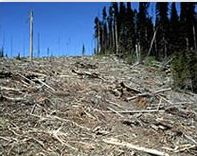America’s public lands suffered nearly a century of relentless commercial logging and road building that have left our forests and watersheds and countless plants and animals in a rapidly deteriorating condition. It will take heroic effort to restore our national forests and simultaneously revitalize rural communities by creating sustainable economic activities. NFPA is working to promote bona-fide, ecologically based restoration projects which put people in rural communities to work conducting road removal and watershed restoration activities.
Since 2005 marks the Forest Service’s centennial, we believe there is a golden opportunity to make the focus of the next 100 years of Forest Service management the “Restoration Century.”
we believe there is a golden opportunity to make the focus of the next 100 years of Forest Service management the “Restoration Century.”
While some, including the Forest Service, argue that more industrial logging is needed to restore our forests, we believe the first step in the restoration process is to prevent further ecological degradation by protecting our national forests from industrial logging and other forms of resource extraction.
Next, we need to redirect taxpayer subsidies currently going to support industrial logging towards ecologically-based restoration projects – such as road removal and watershed restoration – with the goal of restoring natural processes and reestablishing fully functioning ecosystems. Only once this happens will we see the Forest Service’s management of national forests in step with the desires of an American public who want to see our forests protected and restored.
Unfortunately, because the Forest Service’s budgets are still tied to industrial logging and resource extraction – not forest protection and restoration – the public’s clean water, wildlife habitat, wildlands and recreational opportunities continue to be squandered. Just consider these facts:
– There are 445,000 miles of roads on national forests – enough to circle the Earth 18 times – and the Forest Service faces a $10 billion road maintenance backlog.
– An estimated 50% of riparian areas on national forests require restoration due to impacts from industrial logging, roadbuilding, grazing, mining and off-road vehicles.
– Less than 5% of America’s ancient, old-growth forests remain.
– 421 wildlife species that call national forests home are in need of protective measures provided by the Endangered Species Act.
https://www.360a.global
